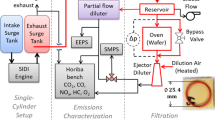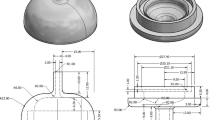Abstract
Membrane filtration has been demonstrated to be effective for the removal of liquid-borne nanoparticles (NPs). Such technique can be applied to purify and disinfect drinking water as well as remove NPs in highly pure chemicals used in the industries. This study aims to study the filtration process of a model membrane filter, the Nuclepore filter. Experiments were carried out using standard filtration tools and the nanoparticle tracking analysis (NTA) technique was used to measure particle (50–500 nm) concentration upstream and downstream of the filter to determine the filtration efficiency. The NTA technique has been calibrated using 150-nm polystyrene latex particles to determine its accuracy of particle concentration measurement. Measurements were found reliable within a certain concentration limit (about 108–1010 particles/cm3), which is dependent on the camera settings during the measurement. Experimental results are comparable with previously published data obtained using the aerosolization method, validating the capability of the NTA technique. The capillary tube model modified from that developed for aerosol filtration was found to be useful to represent the experimental results, when a sticking coefficient of 0.15 is incorporated. This suggests that only 15% of the particle collisions with the filter results in successful attachment. The small sticking coefficient found can be explained by the unfavorable surface interactions between the particles and the filter medium.







Similar content being viewed by others
References
Botes M, Cloete TE (2010) The potential of nanofibers and nanobiocides in water purification. Crit Rev Microbiol 36:68–81
Brown RC (1993) Air filtration. Pergamon Press, London
Cyrs WD, Boysen DA, Casuccio G, Lersch T, Peters TM (2010) Nanoparticle collection efficiency of capillary pore membrane filters. J Aerosol Sci 41(7):655–664
Domingos RF, Baalousha MA, Ju-Nam Y, Reid MM, Tufenkji N, Lead JR, Leppard GG, Wilkinson KJ (2009) Characterizing manufactured nanoparticles in the environment: multimethod determination of particle sizes. Environ Sci Technol 43:7277–7284
Filipe V, Hawe A, Jiskoot W (2010) Critical evaluation of nanoparticle tracking analysis (NTA) by nanoSight for the measurement of nanoparticles and protein aggregates. Pharm Res 27:796–810
Guo H, Wyart Y, Perot J, Nauleau F, Moulin P (2010) Low-pressure membrane integrity tests for drinking water treatment: a review. Water Res 44:41–57
Hinds WC (1999) Aerosol technology: properties, behavior, and measurement of airborne particles. Wiley, New York
John W, Reischl G, Goren S, Plotkin D (1978) Anomalous filtration of solid particles by nuclepore filters. Atmos Environ 12:1555–1557
Laxen DPH, Chandler IM (1982) Comparison of filtration techniques for size distribution in fresh-waters. Anal Chem 54:1350–1355
Lee JK (1992) Particulate retention by microporous membrane filters in liquid filtration. PhD Thesis, University of Minnesota
Ling TY, Wang J, Pui DYH (2010) Measurement of retention efficiency of filters against nanoparticles in liquids using an aerosolization technique. Environ Sci Technol 44:774–779
Lippa P, Mueller U, Hetzer B, Wagner T (2009) Characterization of nanoparticulate fouling and breakthrough during low-pressure membrane filtration. Desalin Water Treat 9:234–240
Logan BE (1993) Theoretical analysis of size distributions determined with screens and filters. Limnol Oceanogr 38:372–381
Logan BE, Hilbert TA, Arnold RG (1993) Removal of bacteria in laboratory filters—models and experiments. Water Res 27:955–962
Lundhal P, Stokes R, Smith E, Martin R, Graham D (2008) Synthesis and characterisation of monodispersed silver nanoparticles with controlled size ranges. Micro Nano Lett 3:62–65
Madaeni SS (1999) The application of membrane technology for water disinfection. Water Res 33:301–308
Nassar T, Rom A, Nyska A, Benita S (2009) Novel double coated nanocapsules for intestinal delivery and enhanced oral bioavailability of tacrolimus, a P-gp substrate drug. J Control Release 133:77–84
Rubow KL, Liu BYH (1986) Characteristics of membrane filters for particle collection. In: Raber RR (ed) Fluid filtration: gas, vol 1, ASTM STP 975. American Society for Testing and Materials, Philidelphia
Savage N, Diallo MS (2005) Nanomaterials and water purification: opportunities and challenges. J Nanopart Res 7:331–342
Smith TN, Phillips CR (1975) Inertial collection of aerosol-particles at circular aperture. Environ Sci Technol 9:564–568
Smith TN, Phillips CR, Melo OT (1976) Diffusive collection of aerosol-particles on nuclepore membrane-filter. Environ Sci Technol 10:274–277
Spurny KR, Lodge JP, Frank ER, Sheesley DC (1969) Aerosol filtration by means of Nuclepore filters: structural and filtration properties. Environ Sci Technol 3:453–464
Tanny GB, Strong DK, Presswood WG, Meltzer TH (1979) Adsorptive retention of pseudomonas diminuta by membrane filters. J Parenter Drug Assoc 33:40–51
Trushkevych O, Collings N, Hasan T, Scardaci V, Ferrari AC, Wilkinson TD, Crossland WA, Milne WI, Geng J, Johnson BFG, Macaulay S (2008) Characterization of carbon nanotube-thermotropic nematic liquid crystal composites. J Phys D Appl Phys 41:125106
Van Hoecke K, Quik JTK, Mankiewicz-Boczek J, De Schamphelaere KAC, Elsaesser A, Van der Meeren P, Barnes C, McKerr G, Howard CV, Van De Meent D, Rydzynski K, Dawson KA, Salvati A, Lesniak A, Lynch I, Silversmit G, De Samber B, Vincze L, Janssen CR (2009) Fate and effects of CeO2 nanoparticles in aquatic ecotoxicity tests. Environ Sci Technol 43:4537–4546
Wang J, Kim SC, Pui DYH (2008a) Investigation of the figure of merit for filters with a single nanofiber layer on a substrate. J Aerosol Sci 39:323–334
Wang J, Kim SC, Pui DYH (2008b) Figure of merit of composite filters with micrometer and nanometer fibers. Aerosol Sci Technol 42:722–728
Wang J, Kim SC, Pui DYH (2011) Carbon nanotube penetration through a screen filter: numerical modeling and comparison with experiments. Aerosol Sci Technol 45:443–452
Yao KM, Habibian MT, O’Melia CR (1971) Water and waste water filtration: concepts and applications. Environ Sci Technol 5:1105–1112
Acknowledgments
The authors thank the support of members of the Center for Filtration Research: 3M Corporation, Boeing Company, Cummins Filtration Inc., Donaldson Company, Inc., Entegris Inc, Hollingsworth & Vose Company, Samsung Semiconductor Inc., Shigematsu Works CO., LTD, TSI Inc., and W. L. Gore & Associates and the affiliate member National Institute for Occupational Safety and Health (NIOSH). Parts of this study were carried out in the Characterization Facility, University of Minnesota, which receives partial support from NSF through the MRSEC program. Financial support of the Abplanalp-Sanders Memorial Fellowship is also acknowledged.
Author information
Authors and Affiliations
Corresponding author
Electronic supplementary material
Below is the link to the electronic supplementary material.
Rights and permissions
About this article
Cite this article
Ling, T.Y., Wang, J. & Pui, D.Y.H. Measurement of filtration efficiency of Nuclepore filters challenged with polystyrene latex nanoparticles: experiments and modeling. J Nanopart Res 13, 5415–5424 (2011). https://doi.org/10.1007/s11051-011-0529-2
Received:
Accepted:
Published:
Issue Date:
DOI: https://doi.org/10.1007/s11051-011-0529-2




